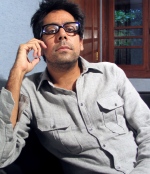
Film
Fri, 22 and Sat, 23 September, 9.15 pm
„John & Jane" by Ashim Ahluwalia, 83 Min, Englisch with German subtitles
Kino Orfeos Erben, Hamburger Allee 45, Frankfurt
Fri Ashim Ahluwalia will be present
John & Jane
Short Synopsis
 A fresh new blend of observational documentary and tropical science-fiction, JOHN & JANE follows the stories of six "call agents" that answer American 1-800 numbers in a Mumbai call center. After a heavy mix of American "culture training" and 14 hour night shifts, the job soon starts to take its toll. Counter pointing the fluorescent interiors of late night offices and hyper-malls with the uneasy currents swirling around the characters, JOHN & JANE discovers a young generation of urban Indians that are beginning to live between the real and the virtual. However, this futuristic world of American aliases and simulated reality is not science fiction, these are the times in which we live. JOHN & JANE raises disturbing questions about the nature of personal identity and what it means to be "Indian" in a 21st century globalised world.
A fresh new blend of observational documentary and tropical science-fiction, JOHN & JANE follows the stories of six "call agents" that answer American 1-800 numbers in a Mumbai call center. After a heavy mix of American "culture training" and 14 hour night shifts, the job soon starts to take its toll. Counter pointing the fluorescent interiors of late night offices and hyper-malls with the uneasy currents swirling around the characters, JOHN & JANE discovers a young generation of urban Indians that are beginning to live between the real and the virtual. However, this futuristic world of American aliases and simulated reality is not science fiction, these are the times in which we live. JOHN & JANE raises disturbing questions about the nature of personal identity and what it means to be "Indian" in a 21st century globalised world.
FILMMAKER'S STATEMENT
by Ashim Ahluwalia
 I first heard about call centers in 2001. There had already been some TV documentaries and news reports on the subject, but most of these were occupied with business advantages and technological growth. Nobody seemed to be curious about the kind of people who worked there; for me, the idea of virtual .call agents. with fake identities seemed like science fiction. Who were these Indians that became "Americans" at night?
I first heard about call centers in 2001. There had already been some TV documentaries and news reports on the subject, but most of these were occupied with business advantages and technological growth. Nobody seemed to be curious about the kind of people who worked there; for me, the idea of virtual .call agents. with fake identities seemed like science fiction. Who were these Indians that became "Americans" at night?
I grew up in Bombay in the 70s and 80s which was a different place. There was one B&W channel on television, and you had to book a "trunk call" a couple of hours in advance to dial internationally. India mainly exchanged technology with the Russians and Coca - Cola wasn’t available -- only the Indian version, Thums Up! I went abroad to study for a few years and returned in the 90s to a new, post-liberalized Bombay - now Mumbai. The socialist feel was gone, and there were new landscapes of malls and multiplexes. The government had finally opened the country to investment and people were having their first taste of McDonald’s. I wanted to document this transition, because I knew this awkward moment would not last very long. Like elsewhere in Asia, this universe of Amway and discount coupons would soon become commonplace.
Shooting a film set in a call center seemed like a natural way of looking at this new generation of future Indians who live in India and abroad simultaneously. What we discovered while making this film was incredible - characters who had a hard time separating the real from the virtual.
The strange nature of this world of replicas dictated the structure of the film. It seemed meaningless to make a cinema-verité portrait of a call agent, who fakes his identity – that’s fiction already! It also seemed futile to focus on just one character, when the agents already exist in the most fragmentary ways:One collects only names, the other only numerical data, etc. Since the call center functions like a hive, with agents assigned to teams and leaders, it seemed more appropriate to make a film about a network of individuals - six, the number in a team. In the film, there are 3 sets of Johns & Janes - who appear in order of their team’s ranking. In that sense, the film documents the transition from Indian (worst sales ranking) to American (highest sales). The cosmos of call centers was weirder than we imagined. Shooting inside was not easy, particularly with a 35mm camera and very heavy restrictions on what we were allowed to shoot. Shooting video would have been much easier, but we gained something interesting by choosing to shoot film and shooting static, rather than handheld. The film feels almost fictional at times. and makes you wonder what kind of "documentary" this is.


